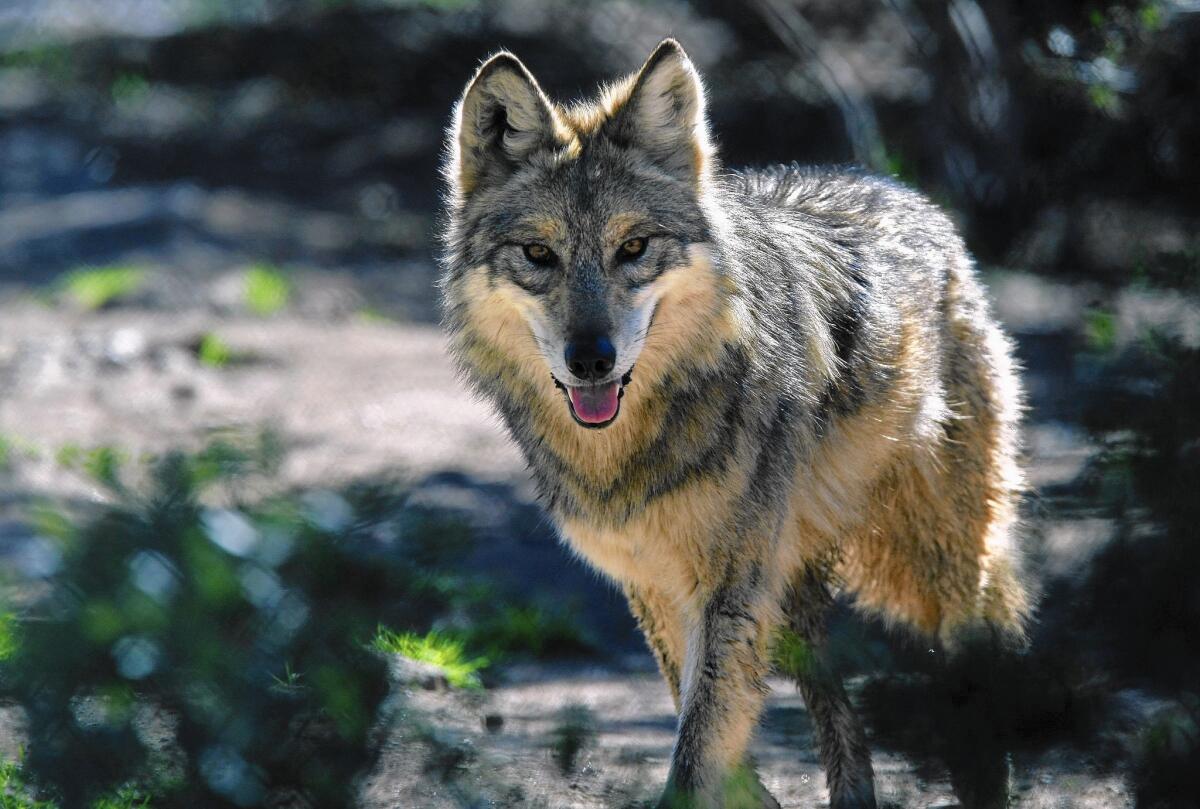DNA indicates long-ago Southland wolf was actually a Mexican gray

- Share via
The only wolf ever documented in Southern California may have been a victim of mistaken identity nearly a century ago.
The 100-pound male wolf was pursuing a bighorn sheep in the Mojave Desert’s rugged Providence Mountains in 1922 when a steel-jaw trap clamped onto one of its legs.
Based on measurements of its skull, biologists at the time determined that it was a lone Southern Rocky Mountain gray wolf that had wandered out of a population in southern Nevada.
But a different story is emerging from a study of that skull at UCLA, where researchers have identified DNA markers indicating it was actually a Mexican gray wolf, the “lobo” of Southwestern lore.
Bob Wayne, an evolutionary biologist at the university, said the finding could help extend the historic range of the federally endangered Mexican gray wolf, which the U.S. Fish and Wildlife Service contends ranged over parts of central and northern Mexico, western Texas, southern New Mexico and southeastern and central Arizona.
“Broadening the species’ historical range to include Southern California would allow for an assessment of additional habitats for Mexican wolf reintroduction programs,” Wayne said. That, in turn, could enhance its chances of survival.
“These results are provocative,” Wayne said. “They are also very preliminary and need to be verified by additional analysis.”
Environmentalists are optimistic that the discovery will help improve programs dedicated to helping the subspecies scientists know as Canis lupus baileyi reestablish residency in old lairs.
Michael Robinson, a wolf expert with the Center for Biological Diversity, said that “one day, perhaps many years from now, it could lead to a carefully managed wolf reintroduction program in suitable portions of Southern California’s wilds.”
The Mexican wolf is the smallest subspecies of gray wolf in North America. It can reach 5 feet in length and weigh 50 to 100 pounds, and it has a coat that is a mix of gray, red and black.
Once numbering in the hundreds of thousands, the Mexican wolf was reduced to seven individuals by the 1960s after relentless trapping, poisoning and shooting — first by frontiersmen, then by bounty hunters collecting state and federal rewards, and finally by ranchers protecting their cattle and sheep.
Today, a captive population of about 300 is managed in 49 facilities in the U.S. and Mexico under the Assn. of Zoos and Aquariums through the Mexican Wolf Species Survival Plan, a binational program dedicated to breeding the animals for reintroduction back into the southwest.
An additional 109 Mexican wolves roam a designated recovery area in New Mexico and Arizona that is managed by the U.S. Fish and Wildlife Service.
The UCLA discovery came as a surprise to researchers who had been asked by the California Department of Fish and Wildlife to analyze DNA sequences in samples taken from four wolf skeletons at UC Berkeley’s Museum of Vertebrate Zoology. The study was part of an effort to develop a plan to manage the gray wolf’s natural return to Northern California.
That subspecies of wolf was placed on the state’s endangered species list last year — 90 years after the last one in California was killed by a trapper in Lassen County.
Karen Kovacs, the state’s wildlife program manager, said the results of the genetic analysis were shared with federal wildlife authorities.
The Mexican wolf was reintroduced into a small area of eastern Arizona and western New Mexico in 1998 as part of a federal strategy to reach a population of 100 wolves, including 18 breeding pairs, by 2006.
Today, the population stands at 109 wolves, and they are managed under restrictions that do not permit the mobile, clannish hunters to colonize new territory, increasing the likelihood that inbreeding will weaken the species, according to a lawsuit filed by conservation groups a year ago in U.S. District Court in Arizona.
Erin Hunt, director of operations at the nonprofit California Wolf Center in the hills east of San Diego, said the species remains on an ecological knife edge.
Striding toward a pen built under a canopy of pine and oak trees, Hunt nodded toward two female Mexican wolves that were casting wary sidelong glances as they trotted briskly through patches of manzanita, their ears pricked forward.
“They’re as precious as the ‘Mona Lisa,’” she said.







